Related Research Articles
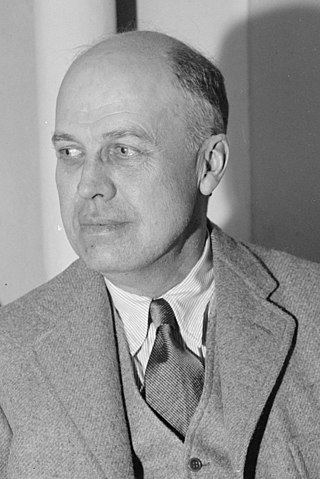
Edward Hopper was an American realist painter and printmaker. While he is widely known for his oil paintings, he was equally proficient as a watercolorist and printmaker in etching.

Visual art of the United States or American art is visual art made in the United States or by U.S. artists. Before colonization, there were many flourishing traditions of Native American art, and where the Spanish colonized Spanish Colonial architecture and the accompanying styles in other media were quickly in place. Early colonial art on the East Coast initially relied on artists from Europe, with John White the earliest example. In the late 18th and early 19th centuries, artists primarily painted portraits, and some landscapes in a style based mainly on English painting. Furniture-makers imitating English styles and similar craftsmen were also established in the major cities, but in the English colonies, locally made pottery remained resolutely utilitarian until the 19th century, with fancy products imported.
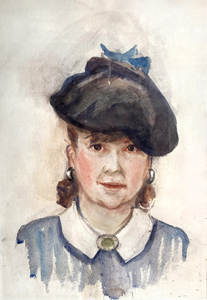
Josephine Verstille Hopper was an American painter who studied under Robert Henri and Kenneth Hayes Miller, and won the Huntington Hartford Foundation fellowship. She was the wife of Edward Hopper, whom she married in 1924.
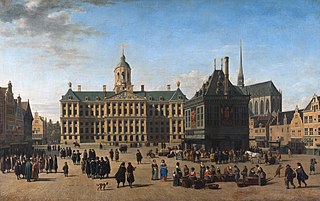
In the visual arts, a cityscape is an artistic representation, such as a painting, drawing, print or photograph, of the physical aspects of a city or urban area. It is the urban equivalent of a landscape. Townscape is roughly synonymous with cityscape, though it implies the same difference in urban size and density implicit in the difference between the words city and town. In urban design the terms refer to the configuration of built forms and interstitial space.

Nighthawks is a 1942 oil-on-canvas painting by the American artist Edward Hopper that portrays four people in a downtown diner late at night as viewed through the diner's large glass window. The light coming from the diner illuminates a darkened and deserted urban streetscape.
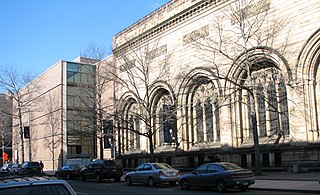
The Yale University Art Gallery (YUAG) is the oldest university art museum in the Western Hemisphere. It houses a major encyclopedic collection of art in several interconnected buildings on the campus of Yale University in New Haven, Connecticut. Although it embraces all cultures and periods, the gallery emphasizes early Italian Renaissance painting, African sculpture, and modern art.

Chop Suey (1929) is an oil painting on canvas by the American artist Edward Hopper. The foreground of the work portrays two women in conversation at a restaurant. In November 2018, it was sold at $92 million, a record price for the artist's work.
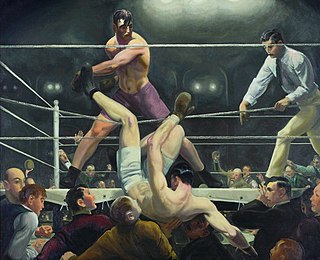
American Realism was a style in art, music and literature that depicted contemporary social realities and the lives and everyday activities of ordinary people. The movement began in literature in the mid-19th century, and became an important tendency in visual art in the early 20th century. Whether a cultural portrayal or a scenic view of downtown New York City, American realist works attempted to define what was real.

Hotel Lobby is a 1943 oil painting on canvas by American realist painter Edward Hopper; it is held in the collection of the Indianapolis Museum of Art (IMA), in Indianapolis, Indiana, United States.

Early Sunday Morning is a 1930 oil painting by American artist Edward Hopper.

Manhattan Bridge Loop is a 1928 oil painting by American artist Edward Hopper, depicting the Manhattan Bridge in New York City. It is on display in the Addison Gallery of American Art of the Phillips Academy in Andover, Massachusetts, which received the painting as a gift from art collector Stephen Carlton Clark in 1932.

Gail Levin is an American art historian, biographer, artist, and a Distinguished Professor of Art History, American Studies, Women's Studies, and Liberal Studies at Baruch College and the Graduate Center of the City University of New York. She is a specialist in the work of Edward Hopper, feminist art, abstract expressionism, Eastern European Jewish influences on modernist art and American modernist art. Levin served as the first curator of the Hopper Collection at the Whitney Museum of American Art.
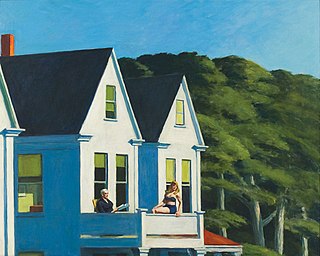
Second Story Sunlight is a 1960 oil painting by the American artist Edward Hopper. It depicts two women of different ages on the second-story balcony of a white house. The older woman reads a newspaper while the younger woman sits on the railing. It is in the collections of the Whitney Museum of American Art, in New York.
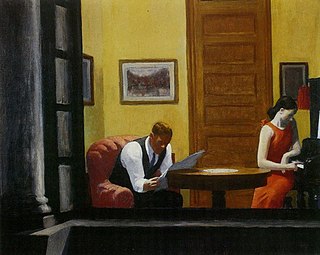
Room in New York is a 1932 oil-on-canvas painting by the American artist Edward Hopper that portrays two individuals in a New York City flat. It is held in the collection of the Sheldon Museum of Art. The painting is said to have been inspired by the glimpses of lighted interiors seen by the artist near the district where he lived in Washington Square.

High Noon is an 1949 oil painting by the American Realist artist Edward Hopper, created in 1949. The work depicts a woman standing and staring outward from the doorway of a home, with the sun casting a split shadow over the home.

Coast Guard Station, Two Lights, Maine is a 1927 oil painting by the American Realist artist Edward Hopper. The work depicts the Cape Elizabeth Lights, a frequent subject of Hopper and wife's frequent summer visits to Cape Elizabeth, Maine. It is held in the Metropolitan Museum of Art, in New York.

New York Movie is an oil on canvas painting by American painter Edward Hopper. The painting was begun in December of 1938 and finished in January of 1939. Measuring 32 1/4 x 40 1/8", New York Movie depicts a nearly empty movie theater occupied with a few scattered moviegoers and a pensive usherette lost in her thoughts. Praised for its brilliant portrayal of multiple light sources, New York Movie is one of Hopper's well-regarded works. Despite the fact that the movie in the painting itself is not known, Hopper's wife and fellow painter Josephine Hopper wrote in her notes on New York Movie that the image represents fragments of snow-covered mountains.

Ground Swell is a 1939 painting by American artist Edward Hopper which depicts five people on a heeling catboat in a light swell, looking at an ominous buoy. It was in the collection of the Corcoran Gallery of Art from 1943 until it was purchased by the National Gallery of Art in Washington, D.C. in 2014.
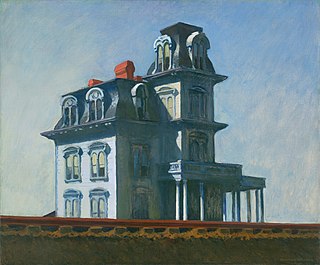
House by the Railroad is a 1925 oil-on-canvas painting by the American artist Edward Hopper.

Sun in an Empty Room is a 1963 painting by American realist Edward Hopper (1882–1967). It is a late period painting completed at his Cape Cod summer home and studio in South Truro, Massachusetts, just four years before his death at age 84. The work depicts a room, seemingly empty, except for light coming through a window, reflecting along the walls and floor. Leaves on a tree or bush can be seen just outside the window.
References
- ↑ "Artist: Edward Hopper, American, 1882–1967 : Western Motel". Artgallery.yale.edu. Retrieved 29 November 2018.